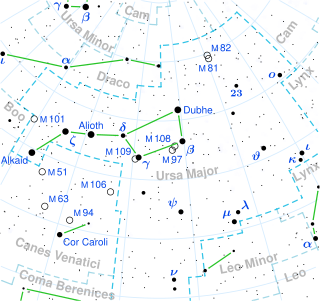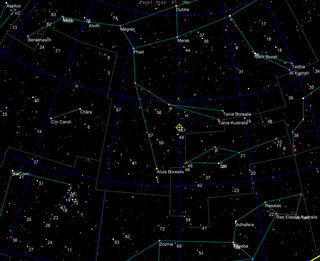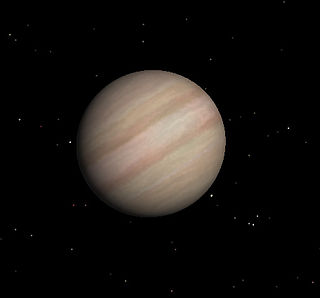
Epsilon Ursae Majoris, officially named Alioth, is, despite being designated "ε" (epsilon), the brightest star in the constellation of Ursa Major, and at magnitude 1.77 is the thirty-third brightest star in the sky.

Ursa Major is a constellation in the northern sky, whose associated mythology likely dates back into prehistory. Its Latin name means "greater she-bear," referring to and contrasting it with nearby Ursa Minor, the lesser bear. In antiquity, it was one of the original 48 constellations listed by Ptolemy in the 2nd century AD. Today it is the third largest of the 88 modern constellations.
14 Herculis or 14 Her is the Flamsteed designation of a K-type main-sequence star approximately 58.5 light-years away in the constellation Hercules. Because of its apparent magnitude, the star cannot be seen with the naked eye. As of 2006, it is thought that 14 Herculis has two extrasolar planets in orbit around the star.

Gamma Ursae Majoris, formally named Phecda, is a star in the constellation of Ursa Major. Since 1943, the spectrum of this star has served as one of the stable anchor points by which other stars are classified. Based upon parallax measurements with the Hipparcos astrometry satellite, it is located at distance of around 83.2 light-years from the Sun.

Beta Ursae Majoris, formally named Merak, is a star in the northern circumpolar constellation of Ursa Major.

47 Ursae Majoris, formally named Chalawan, is a yellow dwarf star approximately 46 light-years from Earth in the constellation of Ursa Major. As of 2011, three extrasolar planets are believed to orbit the star.

70 Virginis b is an extrasolar planet approximately 60 light-years away in the constellation of Virgo. Announced in 1996 by Geoffrey Marcy and R. Paul Butler, 70 Virginis was one of the first stars confirmed to have planets orbiting it. When first announced, 70 Virginis b was considered to be within its star's habitable zone, but it was later confirmed that the planet has an eccentric orbit, closer to its parent.

Iota Ursae Majoris, also named Talitha, is a star system in the northern circumpolar constellation of Ursa Major. It has an apparent visual magnitude of 3.14, making it visible to the naked eye and placing it among the brighter members of this constellation. Based upon parallax measurements, it is located at a distance of 47.3 light-years from the Sun.

Theta Ursae Majoris is a suspected spectroscopic binary star system in the northern circumpolar constellation of Ursa Major. It has an apparent visual magnitude of 3.17, placing it among the brighter members of this constellation. The distance to this star has been measured directly using the parallax method, yielding an estimated value of 43.96 light-years.

Omicron Ursae Majoris, formally named Muscida, is a star system in the northern circumpolar constellation of Ursa Major. It has an apparent visual magnitude of +3.35 and is located at a distance of around 179 light-years from the Sun. In 2012, an extrasolar planet, designated Omicron Ursae Majoris Ab was found to be orbiting the primary.

Kappa Ursae Majoris is a binary star in the constellation of Ursa Major. With a combined apparent magnitude of +3.60, the system is approximately 358 light-years from Earth.

Xi Ursae Majoris, also named Alula Australis, is a star system in the constellation of Ursa Major. On May 2, 1780, Sir William Herschel discovered that this was a binary star system, making it the first such system ever discovered. It was the first visual double star for which an orbit was calculated, when it was computed by Félix Savary in 1828. It is also a variable star with a small amplitude. Xi Ursae Majoris is found in the left hind paw of the Great Bear.

4 Ursae Majoris is the Flamsteed designation of a star in the northern circumpolar constellation of Ursa Major. It also bears the Bayer designation of Pi² Ursae Majoris and is traditionally named Muscida. With an apparent visual magnitude of +4.6, this star is visible from suburban or darker skies based upon the Bortle Dark-Sky Scale. From parallax measurements made during the Hipparcos mission, this star is at a distance of 256 light-years from Earth. As of 2011, one extrasolar planet has been confirmed to be orbiting the star.

47 Ursae Majoris b, formally named Taphao Thong, is a gas planet and an extrasolar planet approximately 46 light-years from Earth in the constellation of Ursa Major. The planet was discovered located in a long-period orbit around the star 47 Ursae Majoris in January 1996 and as of 2011 it is the innermost of three known planets in its planetary system. It has a mass at least 2.53 times that of Jupiter.

47 Ursae Majoris c, formally named Taphao Kaew, is an extrasolar planet approximately 46 light-years from Earth in the constellation of Ursa Major. The planet was discovered located in a long-period around the star 47 Ursae Majoris. Its orbit lasts 6.55 years and the planet has a mass at least 0.540 times that of Jupiter.

14 Herculis b or 14 Her b is an exoplanet approximately 58.5 light-years away in the constellation of Hercules. The planet was found orbiting the star 14 Herculis, with a mass that would likely make the planet a Jovian planet roughly the same size as Jupiter but much more massive. It was discovered in July 1998 by the Geneva Extrasolar Planet Search team. At the time of discovery it was the extrasolar planet with the longest orbital period, though longer-period planets have subsequently been discovered.

Doppler spectroscopy is an indirect method for finding extrasolar planets and brown dwarfs from radial-velocity measurements via observation of Doppler shifts in the spectrum of the planet's parent star.

14 Herculis c or 14 Her c is an extrasolar planet approximately 58.5 light-years away in the constellation of Hercules. The planet was found orbiting the star 14 Herculis, with a mass that would likely make the planet a gas giant roughly the same size as Jupiter but much more massive. This planet was discovered on November 17, 2005 and confirmed on November 2, 2006. According to a recent analysis, the existence of a second planet in the 14 Herculis system is "clearly" supported by the evidence, but the planet's parameters are not precisely known. It may be in a 4:1 resonance with the inner planet 14 Herculis b.










